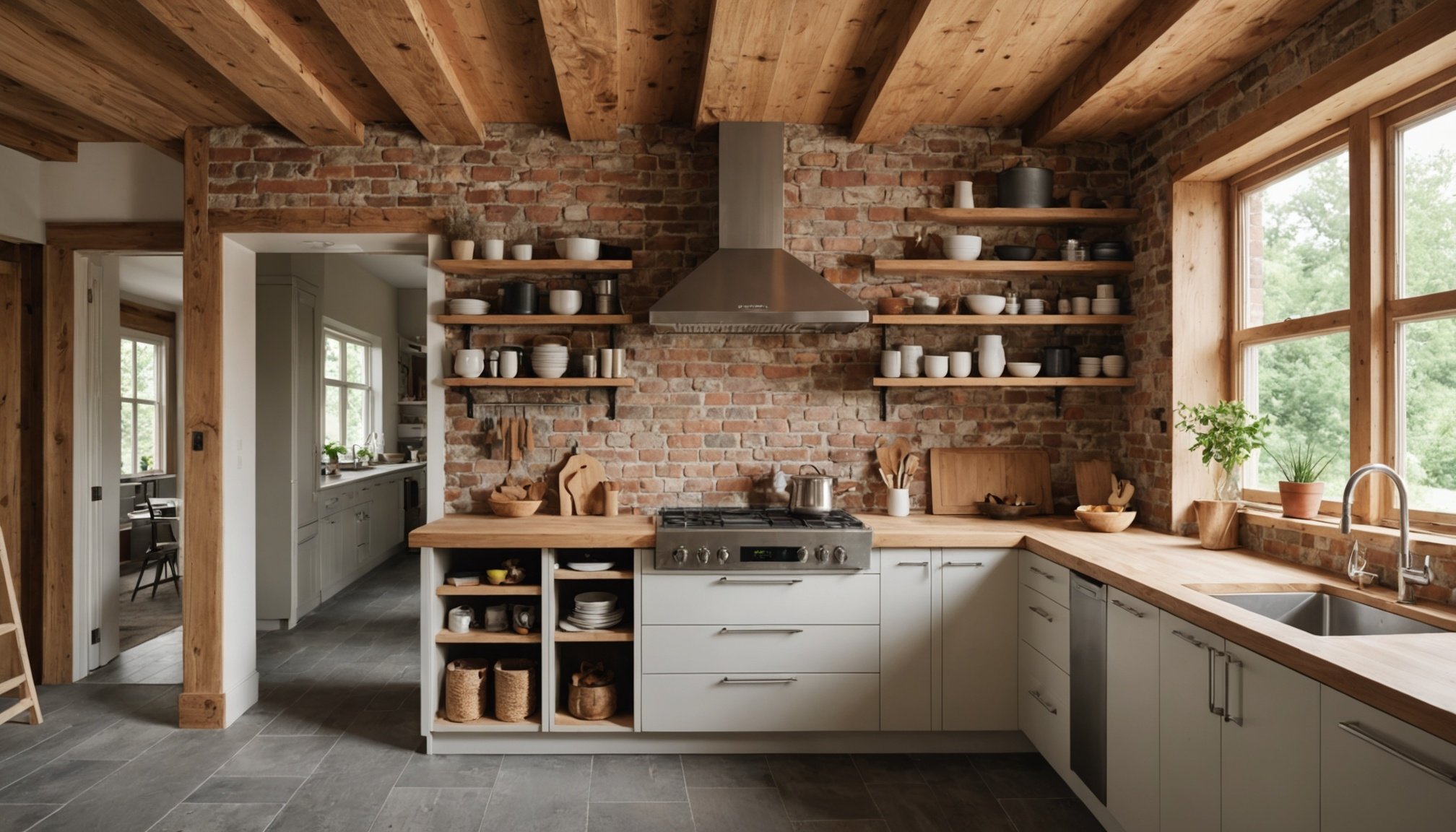Uncover Top Sustainable Materials for Your Next Home Renovation Adventure!
When it comes to renovating your home, making sustainable choices is not only good for the environment, but it can also enhance the aesthetic and functional value of your house. Here’s a comprehensive guide to help you discover and incorporate the best sustainable materials into your next home renovation project.
Why Choose Sustainable Materials?
Before we dive into the specifics, it’s essential to understand why sustainable materials are so important. “Choosing sustainable materials involves opting for those that are renewable, recyclable, and non-toxic,” explains Anthony Michael, an expert in sustainable interior design[3].
Also to read : Dynamic modular furniture ideas: stylish solutions for changing family needs!
Sustainable materials help reduce the environmental impact of your home by conserving natural resources, minimizing waste, and lowering energy consumption. Here are some key reasons to make the switch:
- Conservation of Resources: Sustainable materials are often renewable or recycled, reducing the demand for virgin resources.
- Energy Efficiency: Many sustainable materials are designed to enhance energy efficiency, such as insulation materials that reduce heating and cooling needs.
- Health Benefits: Non-toxic materials ensure a healthier indoor environment, free from harmful chemicals.
- Aesthetic Appeal: Sustainable materials can add unique character and charm to your home, making it stand out.
Plant-Based Materials: The Eco-Friendly Revolution
Plant-based materials are revolutionizing the way we build and design homes. Here are some of the top plant-based materials you should consider:
Also to see : Brighten Up Your Basement Art Studio: Ingenious Ways to Harness Natural Light for Maximum Creativity
Bamboo: The Rapidly Renewable Resource
Bamboo is often referred to as a “grass masquerading as a timber” due to its extraordinary growth rate and ecological benefits. It reaches full maturity in just three to five years, making it a highly sustainable resource. Bamboo plantations absorb up to 12 tons of carbon dioxide per hectare, significantly reducing carbon footprints[2][4].
- Strength and Durability: Bamboo is known for its high tensile strength and durability, making it ideal for flooring, cabinetry, and even structural support.
- Versatility: Bamboo can be used in various applications, from furniture to wall coverings.
- Carbon Sequestration: Bamboo’s rapid growth rate and high carbon absorption make it a powerful ally in combating climate change.
Wheat Straw and Kenaf: Utilizing Agricultural Waste
Materials like wheat straw and kenaf are derived from agricultural waste, providing excellent insulation and reducing the need for new raw materials.
- Wheat Straw: Composed of 98% natural materials, straw-wall panels help capture atmospheric carbon and provide excellent insulation[1].
- Kenaf: This fast-growing plant offers energy savings and is lightweight, making it an excellent choice for sustainable construction[1].
Earth-Based Materials: Natural and Biodegradable
Earth-based materials are stepping into the spotlight as a sustainable choice for modern home design.
Rammed Earth: Durable and Eco-Friendly
Rammed earth walls are made by compacting natural materials like soil and clay into a sturdy, durable structure. This ancient technique is both visually appealing and environmentally sustainable.
- Thermal Mass: Rammed earth walls help regulate indoor temperatures, particularly useful in warmer climates.
- Biodegradable: These materials are biodegradable and support a healthy indoor environment with low carbon footprints[1][4].
Hempcrete: The Modern Eco Marvel
Hempcrete is derived from the core stem of the hemp plant and is gaining traction in eco-friendly construction.
- Lightweight and Breathable: Hempcrete is a unique blend of hemp hurds and lime, resulting in a lightweight, breathable composite.
- Carbon Sequestration: Hempcrete absorbs carbon dioxide as it cures, making it carbon-negative[2][4].
Recycled Materials: Minimizing Waste and Conserving Resources
Recycled materials are a crucial part of sustainable building practices.
Reclaimed Wood: Aesthetic and Sustainable
Reclaimed wood is salvaged from old buildings, barns, or other sources, reducing the demand for new timber.
- Unique Character: Each piece of reclaimed wood carries its unique history, adding rustic charm to any space.
- Conservation: Using reclaimed wood cuts down on waste and helps conserve forest resources[3][5].
Recycled Steel and Aluminum: Strong and Sustainable
Recycled metals are infinitely recyclable, making them a prime choice for sustainable construction.
- Durability: Recycled steel and aluminum are highly durable and structurally sound.
- Energy Savings: These materials reduce the demand for newly mined steel, conserving energy and lowering greenhouse gas emissions[4][5].
Smart Materials: Enhancing Energy Efficiency
Smart materials are designed to respond to environmental changes, optimizing your home’s performance.
Adaptive Insulation: Dynamic Energy Efficiency
Adaptive insulation materials adjust their properties based on temperature changes, ensuring optimal energy efficiency.
- Temperature Regulation: These materials help maintain a consistent indoor temperature, reducing heating and cooling needs.
- Energy Savings: By adapting to environmental changes, adaptive insulation materials can significantly lower energy consumption[1].
Smart Glass: Energy-Efficient Windows
Smart glass technology enhances energy efficiency by responding to light and temperature changes.
- Energy Efficiency: Smart glass can change from transparent to opaque, reducing heat gain in the summer and heat loss in the winter.
- Comfort: This technology ensures a comfortable indoor environment while minimizing the need for heating and cooling systems[1].
Local and Natural Materials: Supporting Regional Economies
Choosing local and natural materials can make a significant impact on sustainability.
Local Sourcing: Reducing Carbon Emissions
Sourcing materials locally reduces transportation emissions and supports regional economies.
- Unique Aesthetic: Local materials add unique regional characteristics to your home, enhancing its aesthetic appeal.
- Economic Benefits: By supporting local economies, you contribute to the well-being of your community[1].
Practical Tips for Your Home Renovation Project
Here are some practical tips to help you incorporate sustainable materials into your home renovation:
Plan Ahead
Before starting your project, research and plan which sustainable materials you will use. Consider factors like availability, cost, and the specific needs of your project.
Consult Professionals
Consult with architects, interior designers, or contractors who specialize in sustainable building practices. They can provide valuable insights and help you make informed decisions.
Use Digital Tools
Utilize digital tools like building performance analysis software to evaluate the environmental impact and energy savings of different materials before construction begins[4].
Detailed Comparison of Sustainable Materials
Here is a comprehensive table comparing some of the top sustainable materials:
| Material | Biomass Benefits | Renewable Resources | Energy Efficiency | Aesthetic Appeal |
|---|---|---|---|---|
| Bamboo | Quick growth, strong, versatile | Harvested every 3-5 years | High | Unique texture |
| Wheat Straw | Insulation, CO2 storage | Utilizes agricultural waste | High | Natural look |
| Kenaf | Energy savings, lightweight | Fast-growing plant | High | Modern appearance |
| Rammed Earth | Durable, eco-friendly | Biodegradable | High | Natural blend |
| Hempcrete | Lightweight, breathable | Carbon-negative | High | Modern, rustic |
| Reclaimed Wood | Unique character, durable | Conserves forest resources | Medium | Rustic charm |
| Recycled Steel | Highly durable, structurally sound | Infinitely recyclable | Medium | Modern, industrial |
| Adaptive Insulation | Dynamic energy efficiency | Responds to temperature changes | High | Invisible integration |
| Smart Glass | Energy-efficient windows | Responds to light and temperature | High | Sleek, modern |
Quotes and Insights from Experts
- “Incorporating reclaimed wood, recycled metal, and glass provides unique aesthetics while minimizing waste and conserving resources,” says Terra Harmonia, emphasizing the importance of sustainable materials in home design[1].
- “Bamboo is a fast-growing, renewable material, ready to be harvested in just three to five years — much quicker than conventional timber,” highlights the blog from Enscape3D, underscoring bamboo’s sustainability[4].
- “Using recycled materials directly contributes to sustainability by reducing the need for virgin materials, which in turn conserves natural resources and decreases environmental impact,” explains Mannagum, emphasizing the circular economy benefits of recycled materials[5].
Choosing sustainable materials for your home renovation is a step towards a greener future. Whether you opt for plant-based materials like bamboo, earth-based materials like rammed earth, or recycled materials like reclaimed wood, each choice counts in achieving sustainability goals.
By understanding the benefits and applications of these materials, you can make informed decisions that not only enhance your home’s aesthetic and functional value but also contribute to a healthier environment. So, embark on your home renovation adventure with a commitment to sustainability, and watch your dream home transform into an eco-friendly haven that tells a story of environmental stewardship.

